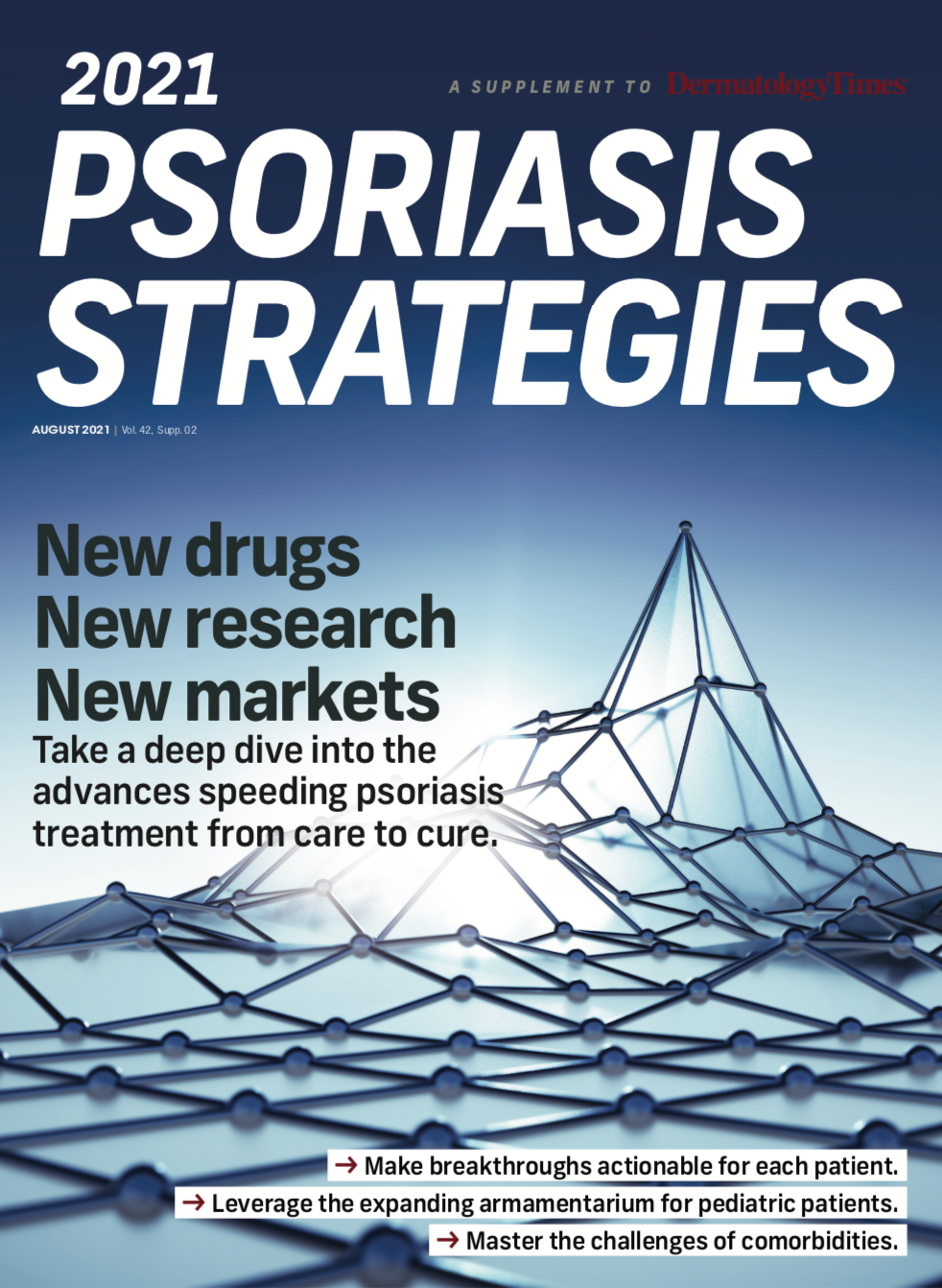- Acne
- Actinic Keratosis
- Aesthetics
- Alopecia
- Atopic Dermatitis
- Buy-and-Bill
- COVID-19
- Case-Based Roundtable
- Chronic Hand Eczema
- Chronic Spontaneous Urticaria
- Drug Watch
- Eczema
- General Dermatology
- Hidradenitis Suppurativa
- Melasma
- NP and PA
- Pediatric Dermatology
- Pigmentary Disorders
- Practice Management
- Precision Medicine and Biologics
- Prurigo Nodularis
- Psoriasis
- Psoriatic Arthritis
- Rare Disease
- Rosacea
- Skin Cancer
- Vitiligo
- Wound Care
Publication
Article
Dermatology Times
Psoriasis, Metabolic Syndrome Connection Expands
Author(s):
Due to the multimorbid nature of the disease, clinicians must screen, monitor, and aggressively treat the associated comorbidities.
A growing body of research adds to evidence that psoriasis’ comorbidities are much further reaching than previously thought. As a result, clinicians need to address this expanding list of possible comorbidities in their approach to patient care, said Tiago Torres, MD, PhD, professor of dermatology at the Instituto de Ciências Biomédicas Abel Salazar at the University of Porto in Portugal, who recently spoke at the European Academy of Dermatology and Venereology (EADV) Spring Symposium 2021.1
Torres said the most common form of psoriasis vulgaris is plaque psoriasis, typically characterized by the presentation of erythematous-raised plaques and thick silvery scales on the skin. Other forms of the disease include pustular, palmoplantar, nail, guttate, inverse, and erythrodermic psoriasis. One in 3 patients with psoriasis may also develop psoriatic arthritis (PsA) and present with signs of swelling, stiffness, and pain in the joints and areas surrounding the joints.
Beyond the characteristic cutaneous signs and symptoms of the disease as well as joint manifestations in the case of PsA, patients with psoriasis also may suffer from ocular inflammation (conjunctivitis, blepharitis, and uveitis), inflammatory bowel disease (ie, Crohn disease and ulcerative colitis), renal disease, chronic obstructive pulmonary disease, and obstructive sleep apnea.
Cardiometabolic diseases now have a place on the list of possible comorbidities. This includes cardiovascular disease, obesity, hypertension, diabetes, hyperlipidemia, and nonalcoholic hepatic steatosis. One or more of these manifestations and symptoms can often lead to anxiety, reactive depression, and suicide ideation in patients, underscoring the need for clinicians to monitor and screen this patient population for any of these comorbidities.
“Fortunately, our collective knowledge of psoriasis and the systemic impact that the disease can have on other tissues and organ systems has grown over the [past few] years, with particular focus on cardiometabolic comorbidities,” Torres said. “[Patients with psoriasis] have an increased morbidity and mortality as well as a decreased quality of life due to the multimorbid nature of the disease. As such, it has become paramount that clinicians screen, monitor, and aggressively treat the associated comorbidities of the disease, particularly obesity.”
The physiological explanation for the association between psoriasis and cardiometabolic and cardiovascular disease is slowly becoming better understood. According to Torres, significant systemic inflammation is associated with psoriasis, and this inflammation appears to be at least one of the root causes of the disease.
“The common denominator appears to be systemic inflammation, and there are many similar aspects in terms of the atherosclerotic inflammation, linking psoriasis and cardiovascular disease through systemic inflammation, which perpetuates the cycle of disease,” Torres said.
One of the key comorbidities of psoriasis is obesity, which influences psoriasis and cardiovascular disease. The increased prevalence of cardiovascular comorbidities, especially obesity, is particularly important in psoriasis because of the systemic inflammation produced. Obesity is associated with a constant low-grade chronic inflammatory state, Torres said, and patients with a body mass index higher than 30 have demonstrated a 2-fold risk of developing the disease. According to Torres, the current evidence indicates that weight loss is associated with improvement in psoriasis and PsA severity—likely due to decrease in inflammatory load—improvement in patients’ metabolic profile, and improvement of the response to psoriatic treatments with fewer adverse events.
Torres noted a high prevalence of underdiagnosed and undertreatment of cardiovascular diseases in patients with psoriasis. In a recent nationwide study evaluating the awareness and management of cardiovascular risk of psoriasis among Portuguese dermatologists, Torres found that 40% of physicians did not contribute to cardiovascular risk–factor management, 12% had no knowledge of the association, 15% passed cardiovascular risk–factor management to general practitioners, and 45% actively screened and monitored patients, although mainly for moderate to severe disease.2
“I believe that it is very important to not only increase the awareness of this subject to clinicians and to actively screen and monitor [patients with] psoriasis for these comorbidities, but also to advise patients to lead a healthy lifestyle, including losing excess weight, stopping smoking, and [conducting] regular physical activity,” Torres said.
Interestingly, the group of metabolic abnormalities that define metabolic syndrome also appear to occur more frequently in patients with PsA vs patients with psoriasis or rheumatoid arthritis (RA). In a recent study, Loganathan et al performed a systematic review and meta-analysis to determine the prevalence of metabolic syndrome among patients with PsA, psoriasis, and RA. The investigators searched Medline, PubMed, Embase, Google Scholar, ProQuest, Ebsco Cinahl, Scopus, ScienceDirect, Web of Science, and Cochrane Library for all relevant studies published between January 1990 and August 2019 and included 24, 89, and 53 studies for PsA, psoriasis, and RA, respectively, in the final analysis.3
They found that patients with PsA had a significantly higher prevalence of metabolic syndrome compared to patients with psoriasis or RA. Data showed that the pooled prevalence of metabolic syndrome in PsA populations was 0.46 ± 0.06 vs 0.34 ± 0.03 and 0.31 ± 0.04 in the psoriasis and RA patient populations, respectively. Also, patients with PsA were 1.62 ± 0.036 and 1.66 ± 0.038 times more likely to have metabolic syndrome compared with psoriasis and RA populations.3
The percentages of patients with PsA and metabolic syndrome in the European, Asian, North American, and Middle Eastern groups were 47.2%, 45.78%, 34.88%, and 48.4 %, respectively. In PsA populations, data showed that patients from countries with a lower gross national income (GNI) tended to have a higher prevalence of metabolic syndrome, and the prevalence of PsA was also higher when matched to RA and psoriasis populations from matched GNI groups.3
According to the study authors, rheumatologists often do not assess for metabolic syndrome as part of routine evaluations in patients with inflammatory arthritis.
“Metabolic syndrome is underappreciated in psoriatic disease, especially in psoriatic arthritis. More research needs to be done in determining whether effective management of metabolic syndrome can lead to improved disease control and cardiovascular outcomes,” wrote the study authors.
After addressing the cutaneous manifestations of psoriasis in his patients to improve the skin disease, Torres focuses on decreasing the systemic inflammation in patients, which is crucial to lessening the impact of cardiovascular disease. In addition, screening and treating cardiovascular and cardiometabolic symptoms such as obesity are paramount.
“If we treat the obesity or overweight patients, we are decreasing the risk of the other comorbidities, which will have a positive impact on the global health of the patient,” Torres said.
A multidisciplinary approach is also crucial in the patients with psoriasis who more than likely will have 1 or more comorbidities associated with the skin disease.
“In more complex cases, it would behoove dermatologists to consult with rheumatologists, internists, cardiologists, and endocrinologists as well as general practitioners for a more complete care of the [patient with] psoriasis and [the] associated cardiometabolic diseases,” Torres said.
Disclosures
Torres reported no relevant disclosures.
References:
- Torres T. Is there a need to look for comorbidities in psoriasis? Presented at: European Academy of Dermatology and Venerology Spring Symposium 2021; May 6-7, 2021; virtual. Accessed June 30, 2021.
- Raposo I, Bettencourt A, Selores M, Torres T. Awareness and screening attitudes of Portuguese dermatologists on cardiovascular risk factors in psoriatic patients. Eur J Dermatol. 2017;27(4):443-445. doi:10.1684/ejd.2017.3053
- Loganathan A, Kamalaraj N, El-Haddad C, Pile K. Systemic review and meta-analysis
on prevalence of metabolic syndrome in psoriatic arthritis, rheumatoid arthritis and psoriasis. Int J Rheum Dis. 2021 Published online June 2, 2021. doi:10.1111/1756-185X.14147

Newsletter
Like what you’re reading? Subscribe to Dermatology Times for weekly updates on therapies, innovations, and real-world practice tips.















